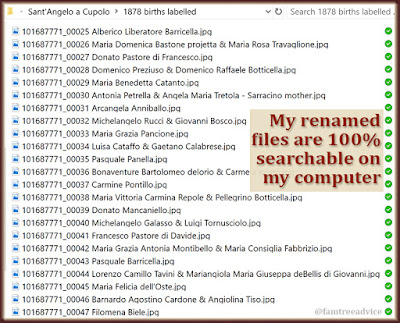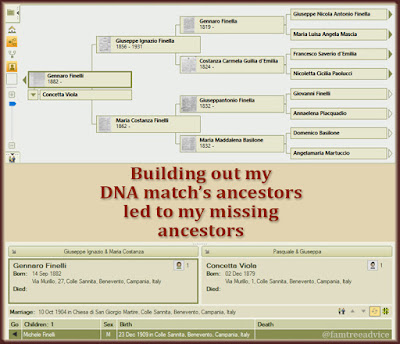There may be related documents with some of the facts you're missing.
One of my 2020 Genealogy Goals is to learn more about my 2nd great grandmother. Her name was Maria Luigia Muollo and her facts are very slim.
She was born in a section of the Southern Italian town of Sant'Angelo a Cupolo in 1843. I have only one source for her year of birth, and it's unreliable. It's the birth record for her youngest child, born in 1879, and it says Maria Luigia was 36 years old. That same birth record tells me Maria Luigia's father's name was Antonio and he was dead by that time.
That's all I know. The available vital records cover 1861–1915 births and 1931–1942 deaths and marriages. I can't go any further back. I can't get Maria Luigia's birth record or her parents' birth, marriage, or death records. I hired a research team in Italy who found that even their church had very limited records. They did find an 1864 marriage record for Maria Luigia and my 2nd great grandfather Giuseppe Sarracino. It has no details but the date.
What bothers me is Maria Luigia's unnamed mother is my only missing 3rd great grandparent. I've identified the other 31, but she remains lost to me.
 |
| Somewhere in here I may find the name of my missing ancestor. |
My 2020 goal is to "Enter all Sant'Angelo a Cupolo births for babies named Muollo into my family tree."
To get this project started, I spent 3 days renaming my collection of vital record images for the town. Thanks to this task, I'm now very familiar with the last names in this ancestral town of mine. I wasn't slowed down by bad handwriting or the occasional mistake. And now I can search my computer for all Muollo documents at once.
There are 72 results. The process is to view each document and try to fit the people into my family tree. The first result (I don't know what determines the order of the results) is:
- Maria Grazia Muollo
- She died on 27 Oct 1941
- She was 73 years old, so she was born around 1868 (and I do have her birth record)
- Her parents were Francesco Saverio Muollo and Fortunata Ruotolo, both dead by 1941
- Her 2nd husband was Vincenzo Pesante (not a last name from this town)
Turning to her 1868 birth record, I learn:
- Maria Grazia Muollo was born on 9 Jun 1868
- Her father Francesco Saverio Muollo was born in 1838 (out of range for my document collection)
- His father was Giacomo Muollo
- Her mother was Maria Fortunata Ruotolo (no age given)
- Maria Fortunata's father was Pasquale Ruotolo
 |
| Please borrow. |
I'll begin adding this family and their facts to my tree. I'll give each person my "No Relationship Established" graphic as a profile image. That makes them instantly recognizable as someone who is not attached to me yet. The moment any of them gets connected and has a relationship to me, I'll remove all their graphics.
Because this last name is important to me, I labelled each Muollo document image with the name of the person's father. Now I can search for "Muollo di Francesco Saverio". (The word "di" means of, and it's a great shorthand for "daughter of" or "son of".)
 |
| All it'll take is one marriage, and this big family may become my close cousins. |
There are 6 results, not counting Maria Grazia's birth and death. I'll open up each image and see if the person's mother was Maria Fortunata Ruotolo.
- Antonio Pasquale Muollo born on 29 Sep 1866. He is a match for this family, so I add him to my family tree.
- Vincenzo Muollo born on 15 Feb 1886. He is also a match for this family, so I add him to my family tree.
- Luigi Muollo born on 18 Apr 1881. He also belongs to this family.
- Another Luigi Muollo born on 16 Jan 1879. He is part of this family, and since there was a Luigi born 2 years later, I know this one died before the 2nd one was born. I can give him a death date of Bef. 18 Apr 1881.
- Maria Giuseppa Muollo born 19 Mar 1873. She also belongs to this family.
- Maria Luisa Muollo born on 19 Oct 1870. She also belongs to this family.
I love working with such a small town. The documents tell me there was only one Francesco Saverio Muollo in town who had kids from 1861–1915.
Francesco Saverio Muollo was about 5 years older than my 2nd great grandmother. But they have different fathers, so they can't be siblings. The closest relationship they could have is 1st cousin. So this family group does not help me learn my 3rd great grandmother's name. At least, not yet.
The prize could be finding someone else's death record that names my 3rd great grandparents.
I'll continue this process by going back to my general "Muollo" search. I'll work my way through each family unit until every Muollo is in my family tree. I'll continue with any "Muollo di Antonio" since that was my 3rd great grandfather's name. When I have everyone in my tree, I can judge whether anyone may be a sibling of my 2nd great grandmother.
I have vital records from several Italian towns where my ancestors lived. This town has the most limited records. But I'll do a lot more work like this. Last year's goal was to enter all the Pozzuto babies from the town of Colle Sannita. Wow, there were a lot of them! And this year's goal is to enter another big group: the Zeolla babies from Colle Sannita.
Entering these family groups—even when there is no connection to me—helps my genealogy research in a 2 big ways:
- Almost all the unrelated people will become my relatives, expanding my family tree.
- These extra branches will help me connect to my DNA matches.
If I'm lucky, there will be some record out there that may lead me to my 3rd great grandmother's missing name. I won't give up on her.





